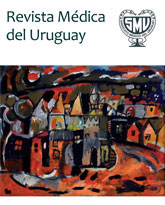Caesarean sections in Uruguay
Abstract
The World Health Organization (WHO) recommends a c-section rate of 15%, understanding that over that figure there is no improvement in maternal-neonatal results. Global distribution of c-section rates is rather uneven and ranges from a deficit (under 5%) and an excess (over 30%). In those countries where they can not have access to it (for instance in African countries) a growing number of c-sections is seen, regardless of the starting point. In Uruguay there is a progressive increase since 2009 (35.3%) and until 2013 (43.7%), although there are several institutions whose rate is over 55%, and even a few rise up to 70%. It is always more usual in the private sector than in the public sector. All maternal complications are greater in the c-section when compared to delivery (haemorrhage needing hysterectomy, complications with anaesthesia, stroke, thromboembolism and greater puerperal infection). Also, fetal pulmonary distress appears as a frequent complication. We analysed the four most widely used arguments to explain the phenomenon: economic benefit for the gynaecologist, women are gradually asking more for a c-section without a medical justification, the increase of legal claims and the fact that the number of women requiring c-sections is also increasing. The study concludes that the c-section rate constitutes a public health issue and it needs to be treated as such. Recommendations are made, a policy by which the WHO recommendations are applied, audits are made and midwives are reinstated as a fundamental and autonomous human resource to assist low risk labors.
References
(2) Healthy People 2020. Maternal, infant and child health: summary of Objectives. Disponible en: http://healthypeople.gov/2020/topicsobjectives2020/pdfs/MaternalChildHealth.pdf. Consulta: 19 noviembre 2014.
(3) Gibbons L, Belizan JM, Lauer JA, Betran AP, Merialdi M, Althabe F. Inequities in the use of cesarean section deliveries in the world. Am J Obstet Gynecol 2012; 206:331.e1-19.
(4) Mortalidad materna en 2005: estimaciones elaboradas por la OMS, el UNICEF, el UNFPA y el Banco Mundial. Disponible en: http://whqlibdoc.who.int/publications/2008/9789243 596211_spa.pdf?ua=1 Consulta: 20 noviembre 2014.
(5) Health at a Glance 2013: OECD Indicators. Disponible en: http://www.oecd.org/els/health-systems/Health-at-a-Glance-2013-Chart-set.pdf Consulta: 19 noviembre 2014.
(6) Centro Latinoamericano de Perinatologia, Salud de la Mujer y Reproductiva. Sistema Informático Perinatal (SIP). Disponible en: http://www.paho.org/clap/index.php?option=com_content&view=article&id=84&Itemid= Consulta: Agosto 2014.
(7) Nisenblat V, Barak S, Griness O, Degani S, Ohel G, Gonen R. Maternal complications associated with multiple cesarean deliveries. Obstet Gynecol 2006; 108:21-6.
(8) Silver R, Landon M, Rouse D, Leveno KJ, Spong CY, Thom EA, et al. Maternal morbidity associated with multiple repeat cesarean deliveries. Obstet Gynecol 2006; 107:1226-32.
(9) Hansen AK, Wisborg K, Uldbjerg N, Henriksen TB. Risk of respiratory morbidity in term infants delivered by elective caesarean section: cohort study. BMJ 2008; 336:85-7.
(10) Keszler M, Carbone MT, Cox C, Schumacher RE. Severe respiratory failure after elective repeat cesarean delivery: a potentially preventable condition leading to extracorporeal membrane oxygenation. Pediatrics 1992; 89:670-2.
(11) McCourt C, Weaver J, Statham H, Beake S, Gamble J, Creedy DK. Elective cesarean section and decision making: A critical review of the literature. Birth 2007; 34:65-79. Disponible en: http://onlinelibrary.wiley.com/doi/10.1111/j. 1523-536X.2006.00147.x/full Consulta: 19 de Nov. de 2014.
(12) Declercq ER, Sakala C, Corry MP, Applebaum S. Listening to mothers II: report of the second national U.S. survey of women’s childbearing experiences. New York: Childbirth Connection, oct. 2006. Disponible en: http://www.childbirthconnection.org/listeningtomothers/ Consulta: Agosto 2014.
(13) Sakala C, Yang YT, Corry MP. Maternity care and liability: pressing problems, substantive solutions. Womens Health Issues 2013; 23(1):e7-13.
(14) Zhang J, Troendle J, Mikolajczyk R, Sundaram R, Beaver J, Fraser W, et al. The natural history of the normal first stage of labor. Obstet Gynecol 2010; 115:705-10.
(15) Leeman L, Leeman R. A Native American community with a 7% cesarean delivery rate: does case mix, ethnicity, or labor management explain the low rate? Ann Fam Med 2003; 1:36-43.
(16) National Institutes of Health Consensus Development Conference Panel. National Institutes of Health Consensus Development conference statement: vaginal birth after cesarean: new insights March 8-10, 2010. Obstet Gynecol 2010; 115:1279-95.
(17) Hannah M, Harrah W, Hewson S, Hodnett ED, Saigal S, Willan AR. Planned caesarean section versus planned vaginal birth for breech presentation at term: a randomized multicentre trial. Lancet 2000; 356(9239):1375-83.
(18) Whyte H, Hannah M, Saigal S, Hewson S, Amankwah K, Cheng M, et al. Outcomes of children at 2 years after planned cesarean birth versus planned vaginal birth for breech presentation at term: the international randomized Term Breech Trial. Am J Obstet Gynecol 2004; 191(3):864-71.
(19) Hannah M, Whyte H, Hannah W, Hewson S, Amankwah K, Cheng M, et al. Maternal outcomes at 2 years after planned cesarean section versus planned vaginal birth for breech presentation at term: the international randomized Term Breech Trial. Am J Obstet Gynecol 2004; 191(3):917-27.
(20) Goffinet F, Carayol M, Foidart J, Alexander S, Uzan S, Subtil D, et al. Is planned vaginal delivery for breech presentation at term still an option? Results of an observational prospective survey in France and Belgium. Am J Obstet Gynecol 2006; 194:1002-11.
(21) ACOG Committee on Obstetric Practice. ACOG Committee Opinion No. 340. Mode of term singleton breech delivery. Obstet Gynecol 2006; 108:235-7.
(22) Kotaska A, Menticoglou S, Gagnon R, Farine D, Basso M, Bos H, et al. SOGC clinical practice guideline: Vaginal delivery of breech presentation: no. 226, June 2009. Int J Gynaecol Obstet 2009; 107:169-76.
(23) Biblioteca de Salud Reproductiva de la OMS. Atención durante el parto. Disponible en: http://apps.who.int/rhl/pregnancy_childbirth/childbirth/es/ Consulta: 28 noviembre 2014.

This work is licensed under a Creative Commons Attribution-NonCommercial 4.0 International License.













